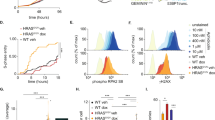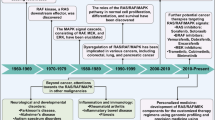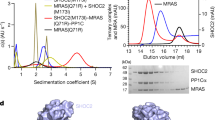Abstract
The p73 gene is capable of inducing cell cycle arrest, apoptosis, senescence, differentiation and to cooperate with oncogenic Ras in cellular transformation. Ras can be considered as a branch point in signal transduction, where diverse extracellular stimuli converge. The intensity of the mitogen-activated protein kinase (MAPK) cascade activation influences the cellular response to Ras. Despite the fundamental role of p53 in Ras-induced growth arrest and senescence, it remains unclear how the Ras/MEK/ERK pathway induces growth arrest in the absence of p53. We report here that oncogenic Ras stabilizes p73 resulting in p73 accumulation and enhancement of its activity. p73, in turn, induces a sustained activation of the MAP kinase cascade synergizing with oncogenic Ras. We also found that inhibition of p73 function modifies the cellular outcome to Ras activation inhibiting Ras-dependent differentiation. Here, we show for the first time that there is a signaling loop between Ras-dependent MAPK cascade activation and p73 function.
Similar content being viewed by others
Log in or create a free account to read this content
Gain free access to this article, as well as selected content from this journal and more on nature.com
or
Abbreviations
- MAPK:
-
mitogen-activated protein kinase
- ERK:
-
extracellular signal-regulated kinase
- pp-ERK:
-
phosphorylated ERK
- Dex:
-
dexamethasone
- CHX:
-
cycloheximide
- p53-DD:
-
dominant-negative p53
- p73-DD:
-
dominant-negative p73
- p73-DD-L371P:
-
inactive dominant-negative p73
- Ph:
-
phalloidin
- Ad:
-
adenovirus
References
Melino G, De Laurenzi V, Vousden KH . p73: friend or foe in tumorigenesis. Nat Rev Cancer 2002; 2: 605–615.
Flores ER, Sengupta S, Miller JB, Newman JJ, Bronson R, Crowley D et al. Tumor predisposition in mice mutant for p63 and p73: evidence for broader tumor suppressor functions for the p53 family. Cancer Cell 2005; 7: 363–373.
Moll UM, Slade N . p63 and p73: roles in development and tumor formation. Mol Cancer Res 2004; 2: 371–386.
Melino G, Lu X, Gasco M, Crook T, Knight RA . Functional regulation of p73 and p63: development and cancer. Trends Biochem Sci 2003; 28: 663–670.
Olson MF, Marais R . Ras protein signalling. Semin Immunol 2000; 12: 63–73.
Qui MS, Green SH . PC12 cell neuronal differentiation is associated with prolonged p21ras activity and consequent prolonged ERK activity. Neuron 1992; 9: 705–717.
Serrano M, Lin AW, McCurrach ME, Beach D, Lowe SW . Oncogenic ras provokes premature cell senescence associated with accumulation of p53 and p16INK4a. Cell 1997; 88: 593–602.
McMahon M, Woods D . Regulation of the p53 pathway by Ras, the plot thickens. Biochim Biophys Acta 2001; 1471: M63–M71.
Vaque JP, Navascues J, Shiio Y, Laiho M, Ajenjo N, Mauleon I et al. Myc antagonizes Ras-mediated growth arrest in leukemia cells through the inhibition of the Ras-ERK-p21Cip1 pathway. J Biol Chem 2005; 280: 1112–1122.
Jung MS, Yun J, Chae HD, Kim JM, Kim SC, Choi TS et al. p53 and its homologues, p63 and p73, induce a replicative senescence through inactivation of NF-Y transcription factor. Oncogene 2001; 20: 5818–5825.
Guerrero I, Pellicer A, Burstein DE . Dissociation of c-fos from ODC expression and neuronal differentiation in a PC12 subline stably transfected with an inducible N-ras oncogene. Biochem Biophys Res Commun 1988; 150: 1185–1192.
Hynds DL, Spencer ML, Andres DA, Snow DM . Rit promotes MEK-independent neurite branching in human neuroblastoma cells. J Cell Sci 2003; 116: 1925–1935.
Marshall CJ . Specificity of receptor tyrosine kinase signaling: transient versus sustained extracellular signal-regulated kinase activation. Cell 1995; 80: 179–185.
Vial E, Marshall CJ . Elevated ERK-MAP kinase activity protects the FOS family member FRA-1 against proteasomal degradation in colon carcinoma cells. J Cell Sci 2003; 116: 4957–4963.
Bunz F, Dutriaux A, Lengauer C, Waldman T, Zhou S, Brown JP et al. Requirement for p53 and p21 to sustain G2 arrest after DNA damage. Science 1998; 282: 1497–1501.
Crespo P, Leon J . Ras proteins in the control of the cell cycle and cell differentiation. Cell Mol Life Sci 2000; 57: 1613–1636.
Vossler MR, Yao H, York RD, Pan MG, Rim CS, Stork PJ . cAMP activates MAP kinase and Elk-1 through a B-Raf- and Rap1-dependent pathway. Cell 1997; 89: 73–82.
Pleasure SJ, Page C, Lee VM . Pure, postmitotic, polarized human neurons derived from NTera 2 cells provide a system for expressing exogenous proteins in terminally differentiated neurons. J Neurosci 1992; 12: 1802–1815.
Pleasure SJ, Lee VM . NTera 2 cells: a human cell line which displays characteristics expected of a human committed neuronal progenitor cell. J Neurosci Res 1993; 35: 585–602.
Sassone-Corsi P, Der CJ, Verma IM . ras-induced neuronal differentiation of PC12 cells: possible involvement of fos and jun. Mol Cell Biol 1989; 9: 3174–3183.
Leppa S, Saffrich R, Ansorge W, Bohmann D . Differential regulation of c-Jun by ERK and JNK during PC12 cell differentiation. EMBO J 1998; 17: 4404–4413.
Eizenberg O, Faber-Elman A, Gottlieb E, Oren M, Rotter V, Schwartz M . p53 plays a regulatory role in differentiation and apoptosis of central nervous system-associated cells. Mol Cell Biol 1996; 16: 5178–5185.
Goldschneider D, Blanc E, Raguenez G, Barrois M, Legrand A, Le Roux G et al. Differential response of p53 target genes to p73 overexpression in SH-SY5Y neuroblastoma cell line. J Cell Sci 2004; 117: 293–301.
Burger H, Nooter K, Boersma AW, Kortland CJ, Stoter G . Expression of p53, Bcl-2 and Bax in cisplatin-induced apoptosis in testicular germ cell tumour cell lines. Br J Cancer 1998; 77: 1562–1567.
Chen X, Ko LJ, Jayaraman L, Prives C . p53 levels, functional domains, and DNA damage determine the extent of the apoptotic response of tumor cells. Genes Dev 1996; 10: 2438–2451.
Marchetti A, Cecchinelli B, D'Angelo M, D'Orazi G, Crescenzi M, Sacchi A et al. p53 can inhibit cell proliferation through caspase-mediated cleavage of ERK2/MAPK. Cell Death Differ 2004; 11: 596–607.
Esteban LM, Vicario-Abejon C, Fernandez-Salguero P, Fernandez-Medarde A, Swaminathan N, Yienger K et al. Targeted genomic disruption of H-ras and N-ras, individually or in combination, reveals the dispensability of both loci for mouse growth and development. Mol Cell Biol 2001; 21: 1444–1452.
Irwin MS, Kondo K, Marin MC, Cheng LS, Hahn WC, Kaelin Jr WG . Chemosensitivity linked to p73 function. Cancer Cell 2003; 3: 403–410.
Irwin M, Marin MC, Phillips AC, Seelan RS, Smith DI, Liu W et al. Role for the p53 homologue p73 in E2F-1-induced apoptosis. Nature 2000; 407: 645–648.
Marin MC, Jost CA, Irwin MS, DeCaprio JA, Caput D, Kaelin Jr WG . Viral oncoproteins discriminate between p53 and the p53 homolog p73. Mol Cell Biol 1998; 18: 6316–6324.
Ozaki T, Hosoda M, Miyazaki K, Hayashi S, Watanabe K, Nakagawa T et al. Functional implication of p73 protein stability in neuronal cell survival and death. Cancer Lett 2005; 228: 29–35.
Ferbeyre G, de Stanchina E, Lin AW, Querido E, McCurrach ME, Hannon GJ et al. Oncogenic ras and p53 cooperate to induce cellular senescence. Mol Cell Biol 2002; 22: 3497–3508.
Marin MC, Jost CA, Brooks LA, Irwin MS, O'Nions J, Tidy JA et al. A common polymorphism acts as an intragenic modifier of mutant p53 behaviour. Nat Genet 2000; 25: 47–54.
Angel P, Imagawa M, Chiu R, Stein B, Imbra RJ, Rahmsdorf HJ et al. Phorbol ester-inducible genes contain a common cis element recognized by a TPA-modulated trans-acting factor. Cell 1987; 49: 729–739.
Megiorni F, Mora B, Indovina P, Mazzilli MC . Expression of neuronal markers during NTera2/cloneD1 differentiation by cell aggregation method. Neurosci Lett 2005; 373: 105–109.
De Laurenzi V, Costanzo A, Barcaroli D, Terrinoni A, Falco M, Annicchiarico-Petruzzelli M et al. Two new p73 splice variants, gamma and delta, with different transcriptional activity. J Exp Med 1998; 188: 1763–1768.
Pozniak CD, Radinovic S, Yang A, McKeon F, Kaplan DR, Miller FD . An anti-apoptotic role for the p53 family member, p73, during developmental neuron death. Science 2000; 289: 304–306.
Jost CA, Marin MC, Kaelin Jr WG . p73 is a simian [correction of human] p53-related protein that can induce apoptosis. Nature 1997; 389: 191–194.
Bowman T, Symonds H, Gu L, Yin C, Oren M, Van Dyke T . Tissue-specific inactivation of p53 tumor suppression in the mouse. Genes Dev 1996; 10: 826–835.
Acknowledgements
We thank all the people cited in the text for their generous gift of reagents. We are grateful to A Fernández y A Munoz for their helpful advice and discussion of the manuscript. We also thank NI Fernandez and B Jimenez-Cuenca for their help and advice. We are grateful to Pilar Frade for technical assistance. MCM is especially thankful to PFM y NFM for their love and support. BFG has a fellowship from Consejería de Educación y Cultura de la Junta de Castilla y León and Fondo Social Europeo. MHV and JPV are recipients of predoctoral fellowships from the Spanish Ministerio de Educación y Ciencia. FMG has a fellowship from the University of León, Spain. This work was supported by Grants SAF-4193CO2 and SAF-4193CO1 from the Spanish Ministerio de Educación y Ciencia to MCM and JLS, respectively.
Author information
Authors and Affiliations
Corresponding author
Additional information
Edited by V De Laurenzi
Supplementary Information accompanies the paper on Cell Death and Differentiation website (http://www.nature.com/cdd)
Rights and permissions
About this article
Cite this article
Fernandez-Garcia, B., Vaqué, J., Herreros-Villanueva, M. et al. p73 cooperates with Ras in the activation of MAP kinase signaling cascade. Cell Death Differ 14, 254–265 (2007). https://doi.org/10.1038/sj.cdd.4401945
Received:
Revised:
Accepted:
Published:
Issue date:
DOI: https://doi.org/10.1038/sj.cdd.4401945
Keywords
This article is cited by
-
p73 regulates ependymal planar cell polarity by modulating actin and microtubule cytoskeleton
Cell Death & Disease (2018)
-
p73 is required for appropriate BMP-induced mesenchymal-to-epithelial transition during somatic cell reprogramming
Cell Death & Disease (2017)
-
p73 is required for endothelial cell differentiation, migration and the formation of vascular networks regulating VEGF and TGFβ signaling
Cell Death & Differentiation (2015)
-
Transcription addiction: can we garner the Yin and Yang functions of E2F1 for cancer therapy?
Cell Death & Disease (2014)
-
Regulatory feedback loop between TP73 and TRIM32
Cell Death & Disease (2013)



